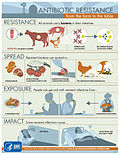Antibiotic use in livestock
Antibiotic use in livestock refers to the practice of administering antibiotics to livestock to promote growth and prevent diseases. This practice has been prevalent in the agriculture and animal husbandry industries for several decades. However, it has been a subject of controversy due to its potential impact on antibiotic resistance in humans and the environment.
History
The use of antibiotics in livestock began in the mid-20th century, following the discovery of antibiotics. Initially, antibiotics were used to treat sick animals. However, farmers soon discovered that regular, low doses of antibiotics could promote growth in livestock, leading to the widespread use of antibiotics as growth promoters.
Use and Administration
Antibiotics are administered to livestock in various ways. They can be added to the animals' feed or water, or they can be injected directly into the animals. The type and amount of antibiotics used depend on the species of livestock, their age, and their health status.
Impact on Antibiotic Resistance
The use of antibiotics in livestock has been linked to the emergence of antibiotic-resistant bacteria. These bacteria can spread to humans through the consumption of contaminated meat or dairy products, or through contact with infected animals or their environment. This can lead to infections that are difficult to treat, posing a significant threat to public health.
Regulation
In response to the threat of antibiotic resistance, many countries have implemented regulations to control the use of antibiotics in livestock. These regulations vary widely, with some countries banning the use of antibiotics as growth promoters, while others have implemented stricter controls on the types and amounts of antibiotics that can be used.
Alternatives to Antibiotics
Due to the risks associated with antibiotic use in livestock, there has been increasing interest in developing alternatives to antibiotics. These include probiotics, prebiotics, and vaccines, which can promote animal health and growth without contributing to antibiotic resistance.
See Also
- Antibiotic resistance
- Livestock
- Agriculture
- Animal husbandry
- Growth promoters
- Probiotics
- Prebiotics
- Vaccines
Transform your life with W8MD's budget GLP-1 injections from $125.
W8MD offers a medical weight loss program to lose weight in Philadelphia. Our physician-supervised medical weight loss provides:
- Most insurances accepted or discounted self-pay rates. We will obtain insurance prior authorizations if needed.
- Generic GLP1 weight loss injections from $125 for the starting dose.
- Also offer prescription weight loss medications including Phentermine, Qsymia, Diethylpropion, Contrave etc.
NYC weight loss doctor appointments
Start your NYC weight loss journey today at our NYC medical weight loss and Philadelphia medical weight loss clinics.
- Call 718-946-5500 to lose weight in NYC or for medical weight loss in Philadelphia 215-676-2334.
- Tags:NYC medical weight loss, Philadelphia lose weight Zepbound NYC, Budget GLP1 weight loss injections, Wegovy Philadelphia, Wegovy NYC, Philadelphia medical weight loss, Brookly weight loss and Wegovy NYC
|
WikiMD's Wellness Encyclopedia |
| Let Food Be Thy Medicine Medicine Thy Food - Hippocrates |
Medical Disclaimer: WikiMD is not a substitute for professional medical advice. The information on WikiMD is provided as an information resource only, may be incorrect, outdated or misleading, and is not to be used or relied on for any diagnostic or treatment purposes. Please consult your health care provider before making any healthcare decisions or for guidance about a specific medical condition. WikiMD expressly disclaims responsibility, and shall have no liability, for any damages, loss, injury, or liability whatsoever suffered as a result of your reliance on the information contained in this site. By visiting this site you agree to the foregoing terms and conditions, which may from time to time be changed or supplemented by WikiMD. If you do not agree to the foregoing terms and conditions, you should not enter or use this site. See full disclaimer.
Credits:Most images are courtesy of Wikimedia commons, and templates, categories Wikipedia, licensed under CC BY SA or similar.
Contributors: Prab R. Tumpati, MD






